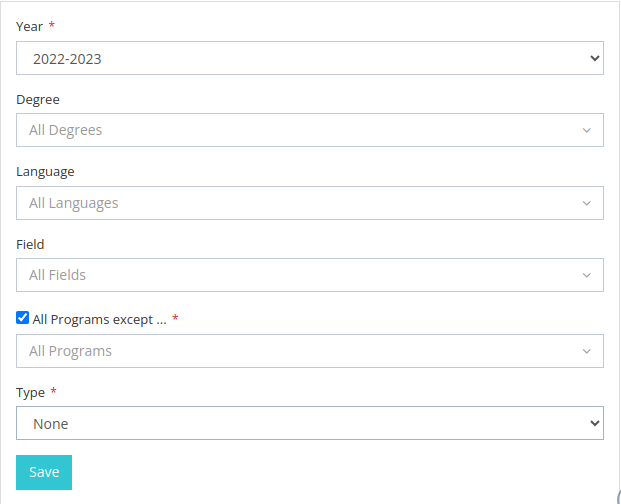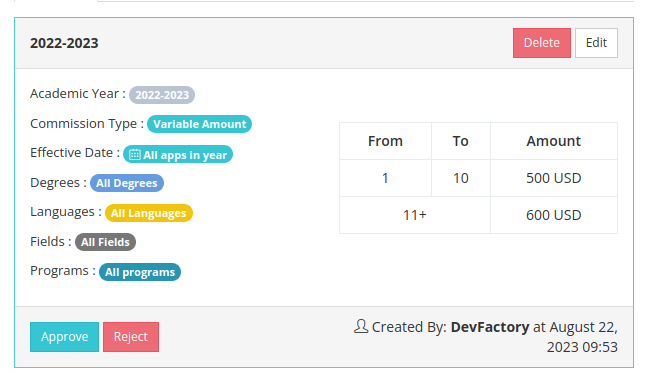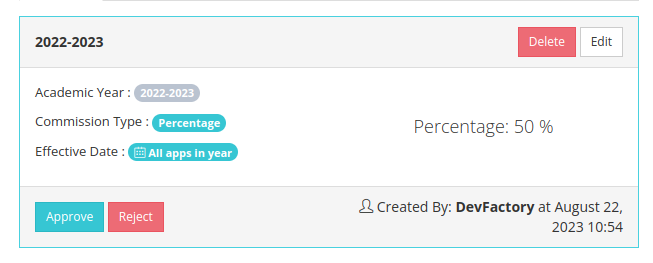Commission
- Introduction
- Institution Commission
- Program Commission
- Agent Commission
- Activating Commission
- Commission History
- Commission Types
- Commission on Program Search
Introduction
In the context of OTAS (OkTamam Admission System), commissions are classified into two types. The first type is the commission collected from each institution when OkTamam company successfully completes an application on their behalf. In this document, we will refer to it as "institution commission." The second type of commission is provided by OkTamam company to the agents who collaborate with OkTamam, typically as a portion of the commission obtained from the institutions. In this document, we will denote it as "agent commission."
Institution Commission
The institution commission is determined based on various parameters, including academic year, program degree, program study language, program field, and specific programs. It's important to note that this commission should be unique across these values. Among these parameters, only the academic year is mandatory, while the others can be left empty. Additionally, an institution has the flexibility to configure multiple commissions, and these commissions will be applicable to all programs within that institution.

The programs within the commission structure are categorized into two types: 'include' and 'except.' When the type is set to 'include,' it signifies that the commission will be applicable exclusively to the selected programs. Conversely, when the type is 'except,' the commission will be applied to all programs except those that have been specifically excluded.

Note:
Effective Datein institution commission config determines when the commission applies, for either all year's applications or those completed after a specified date.
Program Commission
The program commission operates in a similar manner to the institution commission, employing the same commission types. However, the key difference is that when a specific program has a commission configured, it will take precedence and override any commission applied to it from the institution. In essence, program-specific commissions have priority over institution-wide commissions for that particular program.

Agent Commission
The agent commission is calculated as a percentage of the institution commission collected from the respective institution. Agents can have multiple commission percentages based on the academic year of the applications they register. Agents earn their commission when they successfully register an application for a student and subsequently complete the application process. This approach ensures that agents receive their deserved commission for their contributions to the application and enrollment process.
Note: The commission amount is calculated based on completed applications completed by the agent or any of the agent's sub-agents and is not derived from all completed applications within the institution. This individualized calculation ensures that the commission is attributed specifically to the agent's efforts and those of their sub-agents, rather than being influenced by the institution's overall activity.

Activating Commission
The commission configuration involves multiple levels of permissions and a structured approval process. When a user with the "create commission" permission creates a commission, it initially appears as "pending." It remains in this status until someone with the "approve commission" permission reviews and approves it. Once approved, any subsequent changes made to the commission will return it to a "pending" status. These changes do not impact the commission for any applications until they are reviewed and approved again by a user with the appropriate permission. This structured approach ensures that commission changes are carefully reviewed and approved before they are applied to applications.
Commission History
The commission history feature tracks every change made to the commission configuration, providing a detailed record of what changes were made, who made them, and when they occurred. This historical tracking ensures transparency and accountability in the commission management process, allowing users to review the entire change history for reference and auditing purposes.
Commission Types
The commission system encompasses several distinct types, each with its own unique details for calculating the commission value. These types include:
None Percentage Exact Amount Variable Amount Special Variable Amount Variable Percentage Special Variable Percentage
Each of these commission types is associated with specific rules and methodologies for determining the commission amount.
None
Indeed, the commission type "none" signifies that no commission is configured for a particular case, and as a result, no commission calculations will be performed. It essentially indicates the absence of any commission-related calculations for that specific scenario.
Percentage
The commission type "Percentage" is utilized to calculate the commission as a percentage of the program price. In this case, the commission amount is determined based on a specified percentage of the program's total price.
Exact Amount
The commission type "Exact Amount" is employed to set a fixed commission value that remains constant regardless of the program price. In this scenario, the commission amount is a predetermined, fixed value that does not depend on the program's price.
Variable Amount
The commission type "Variable Amount" is designed to have a fixed value, regardless of the program price, but it incorporates an additional dimension. This commission type involves a table of ranges, formatted as (from x to y, commission will be z, and so on). When the number of completed applications falls within a specific range, all completed applications within that institution will be subject to the corresponding commission value from the table. However, once the total number of completed applications reaches a new range, all application commissions are recalculated and adjusted to the new commission rate.
Here's an example of the table configuration:
| From | To | Commission |
|---|---|---|
| 1 | 10 | 10 USD |
| 11 | 20 | 12 USD |
| 21 | 50 | 15 USD |
| 51 | 51+ | 20 USD |
In this example, if the number of completed applications falls within the range of 1 to 10, a commission of 10 USD is applied. For completed applications between 11 and 20, the commission is set at 12 USD. If the total completed applications exceed 20, a commission of 15 USD is applied to all subsequent applications.
Special Variable Amount
The commission type "Special Variable Amount" operates similarly to "Variable Amount" in that it uses a fixed value regardless of the program price and employs the same range table. However, it differs in the way it handles commission changes based on completed applications.
In the case of "Special Variable Amount," when the range for completed applications changes, the new range's commission rate is applied only to the new applications received after the change. Previous applications retain their original commission rate and are not recalculated.
Here's an example of the table configuration for "Special Variable Amount":
| From | To | Commission |
|---|---|---|
| 1 | 10 | 10 USD |
| 11 | 20 | 12 USD |
| 21 | 50 | 15 USD |
| 51 | 51+ | 20 USD |
In this example, if the number of completed applications falls within the range of 1 to 10, a commission of 10 USD is applied. If the range changes to 11-20, new applications will receive a commission of 12 USD, while previously completed applications from the 1-10 range will continue to have a commission of 10 USD.
Variable Percentage
The commission type "Variable Percentage" operates in a manner similar to "Variable Amount," but instead of using fixed values, it calculates the commission as a percentage of the program price. The commission rate varies based on the number of completed applications within specific ranges, as defined in the commission table. When the number of completed applications falls within a particular range, the corresponding percentage is applied to the program's total price.
Here's an example of a commission table for "Variable Percentage":
| From | To | Commission (%) |
|---|---|---|
| 1 | 10 | 5% |
| 11 | 20 | 7% |
| 21 | 50 | 10% |
| 51 | 51+ | 15% |
In this example, if the number of completed applications falls within the range of 1 to 10, a commission of 5% is applied to the program's total price. For completed applications between 11 and 20, a commission rate of 7% is used. The commission rate is adjusted based on the number of completed applications within each range, and it is calculated as a percentage of the program's price.
Special Variable Percentage
The commission type "Special Variable Percentage" functions similarly to "Special Variable Amount," but instead of fixed values, it calculates the commission as a percentage of the program price. This type of commission allows for flexibility in commission rates based on the number of completed applications without recalculating previous application commissions.
In "Special Variable Percentage," when the range for completed applications changes, the new range's commission rate is applied only to new applications received after the change. Previous applications retain their original commission rate, which is calculated as a percentage of the program's price.
Here's an example of a commission table for "Special Variable Percentage":
| From | To | Commission (%) |
|---|---|---|
| 1 | 10 | 5% |
| 11 | 20 | 7% |
| 21 | 50 | 10% |
| 51 | 51+ | 15% |
In this example, if the number of completed applications falls within the range of 1 to 10, a commission of 5% is applied to the program's total price. If the range changes to 11-20, new applications will receive a commission rate of 7%, while previously completed applications from the 1-10 range will continue to have a commission rate of 5% based on the program's price.
Commission on Program Search
In the programs search page, when a logged-in user views the available programs, they also see the commission they will receive for each program if they successfully persuade a student to register in that program and complete their application. The commission calculation is performed using the same function used for calculating commissions but with an assumption of +1 completed application. This way, the user can quickly assess the potential commission they could earn for each program by influencing students to enroll and complete their applications.

